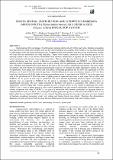| dc.contributor.author | Darius O Andika, AMO Onyango, JC Onyango, H Stutzel | |
| dc.date.accessioned | 2020-08-13T09:27:12Z | |
| dc.date.available | 2020-08-13T09:27:12Z | |
| dc.date.issued | 2010 | |
| dc.identifier.citation | 4 | en_US |
| dc.identifier.issn | 1990-6145 | |
| dc.identifier.uri | https://repository.maseno.ac.ke/handle/123456789/2071 | |
| dc.description.abstract | Intercropping offers advantages if well planned including improved soil fertility and yields. Bambara groundnuts
have been shown to yield in low fertility soils and have been described as a complete food. NERICA rice has been reported
to offer higher yields and shorter growing seasons. Cropping systems that combine both these crops in production systems
will help alleviate malnutrition and food insecurity. Despite these benefits, interaction of the intercrop species in the
intercrop system is key to its success. Differential niche resource mobilization is required for the two crop species to
interact positively and eliminate un-necessary competition. Therefore the objective of this study was to evaluate the roots
spatial distribution and their growth in Bambara groundnuts (Vigna subterranea) and NERICA rice (Oryza sativa)
intercrop system. Greenhouse experiments was set up involving root zone partitioning to allow the roots of the two crops
grow separately and unpartitioning which allowed the roots of the two crops to intermingle and interact. The roots length,
root density, and root volume was evaluated and subjected to analysis of variance and means separated by LSD at 5% level
of significance. Root length, root volume and root density of bambara groundnuts did not show any significant (P>0.05)
differences at 24 and 38 DAS but showed significant (P≤0.05) differences in some root diameter classes at 52 DAS. Root
length was significantly (P≤0.05) higher in bambara groundnuts grown in association with NERICA rice in the same root
zone in the greenhouse at 52 DAS than roots of plants grown in separated root zones as sole crops. On the other hand
NERICA rice 11 grown as sole crop in partitioned root zones showed significantly (P≤0.05) higher root length per
diameter class as compared to NERICA rice 11 grown in association with bambara groundnuts as intercrops in
unpartitioned root zones. The soil volume occupied by bambara roots grown in association with NERICA rice was
significantly (P≤0.05) higher than volume occupied by roots of plants grown in sole system in partitioned root zones.
NERICA rice 11 roots of plants grown in sole system in partitioned root zone showed significantly (P≤0.05) higher root
volume occupation than roots of NERICA rice grown in association with bambara groundnuts in intercrop system in
unpartitioned root zone at 52 DAS. The root length of bambara groundnuts grown in association with NERICA rice 11 was
higher while the root length of NERICA rice was reduced. Similarly growing the two crops in the same root zone resulted
in bambara groundnuts occupying greater soil volume and having higher root density. Therefore this demonstrates
differences in niche activities of the two crops showing better resources mobilization under intercropping system | en_US |
| dc.publisher | Asian Research Publishing Network (ARPN). | en_US |
| dc.subject | Bambara groundnut, NERICA rice, intercropping, root density, growth, yield. | en_US |
| dc.title | Roots spatial distribution and growth in bambara groundnuts (Vigna subterranea) and NERICA rice (Oryza sativa) intercrop system | en_US |
| dc.type | Article | en_US |

